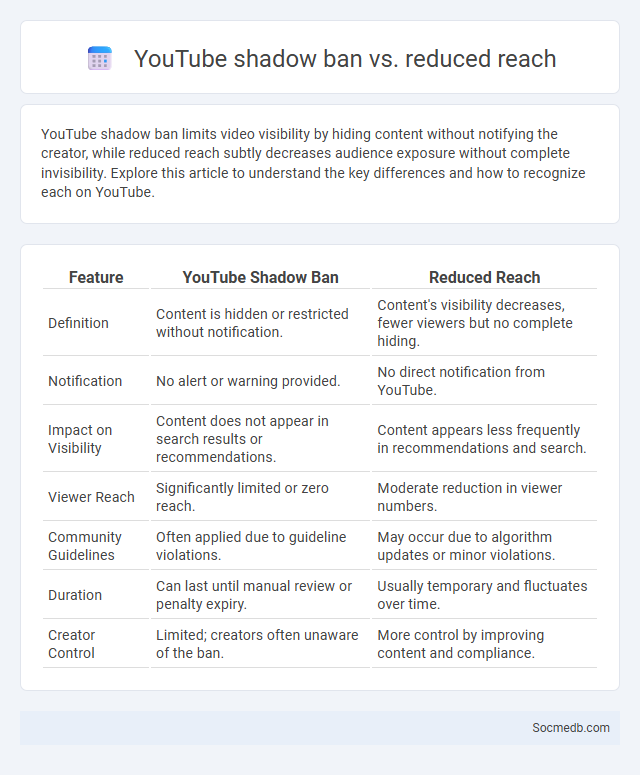
Photo illustration: YouTube shadow ban vs reduced reach
YouTube shadow ban limits video visibility by hiding content without notifying the creator, while reduced reach subtly decreases audience exposure without complete invisibility. Explore this article to understand the key differences and how to recognize each on YouTube.
Table of Comparison
| Feature | YouTube Shadow Ban | Reduced Reach |
|---|---|---|
| Definition | Content is hidden or restricted without notification. | Content's visibility decreases, fewer viewers but no complete hiding. |
| Notification | No alert or warning provided. | No direct notification from YouTube. |
| Impact on Visibility | Content does not appear in search results or recommendations. | Content appears less frequently in recommendations and search. |
| Viewer Reach | Significantly limited or zero reach. | Moderate reduction in viewer numbers. |
| Community Guidelines | Often applied due to guideline violations. | May occur due to algorithm updates or minor violations. |
| Duration | Can last until manual review or penalty expiry. | Usually temporary and fluctuates over time. |
| Creator Control | Limited; creators often unaware of the ban. | More control by improving content and compliance. |
Understanding YouTube Shadow Banning: Definition and Overview
YouTube shadow banning restricts a creator's content visibility without notification, limiting audience reach by hiding videos from search results, recommendations, or subscribers' feeds. This practice often targets content flagged for violating community guidelines or copyright, affecting user engagement and channel growth. Understanding YouTube's algorithmic moderation and appeal processes is crucial for managing shadow ban consequences effectively.
What Is Reduced Reach on YouTube?
Reduced reach on YouTube refers to the platform limiting the visibility of videos in search results, recommendations, and subscriber feeds due to content that violates community guidelines, copyright issues, or low engagement signals. This algorithmic adjustment impacts a video's impressions and viewer count, restricting organic growth and channel exposure. Creators experiencing reduced reach often see decreased watch time and revenue, prompting the need for compliance and optimization strategies.
The Difference Between Shadow Ban and Reduced Reach
Shadow ban limits your content's visibility without explicit notification, making posts invisible or less discoverable to others, particularly on platforms like Instagram and TikTok. Reduced reach occurs when the platform's algorithm decreases content exposure based on engagement metrics, affecting how many followers see your posts without full suppression. Understanding these distinctions helps you strategize content to improve visibility and engagement effectively.
How Does Shadow Banning Work on YouTube?
Shadow banning on YouTube involves the platform limiting the visibility of a user's content without their knowledge, often by restricting video recommendations, search results, or comment reach. The algorithm detects behavior that violates community guidelines or appears spammy, triggering reduced exposure to maintain platform integrity. Users may experience fewer views and interactions as a result, hindering channel growth while the restriction remains undisclosed.
Signs Your YouTube Channel Is Shadow Banned
A significant drop in video views and engagement metrics without explanation often indicates a YouTube channel may be shadow banned. Limited visibility in search results, the disappearance of videos from recommended feeds, and reduced subscriber growth serve as key signs. Monitoring analytics for sudden, unexplained declines helps identify if algorithmic penalties are affecting channel performance.
Causes of Reduced Reach on YouTube Videos
YouTube videos experience reduced reach primarily due to algorithm changes, viewer engagement decline, and content relevance. Low click-through rates and poor watch time signal to the algorithm that the video is less appealing, leading to limited distribution. Inconsistent uploading schedules and neglecting SEO optimization, such as using ineffective keywords and tags, further contribute to decreased visibility and user interaction.
YouTube’s Algorithm: Shadow Ban vs. Audience Limitation
YouTube's algorithm uses sophisticated data analysis to tailor content visibility, sometimes resulting in shadow bans where your videos are hidden without notification, severely reducing your reach. Audience limitation occurs when the algorithm restricts your content to smaller, less engaged groups based on factors like low watch time or user feedback. Understanding these mechanisms helps you optimize videos to maintain and grow genuine audience engagement on the platform.
Recovering from a Shadow Ban on YouTube
Recovering from a shadow ban on YouTube requires understanding the platform's community guidelines and identifying any content that may have triggered the restriction. You can improve your channel's visibility by removing or editing flagged videos, engaging authentically with your audience, and consistently uploading content that complies with YouTube's policies. Monitoring analytics and seeking feedback helps ensure your content aligns with YouTube's standards and restores your channel's reach.
Best Practices to Avoid Shadow Banning and Reduced Reach
Consistently adhere to platform guidelines by avoiding spammy behavior, excessive hashtag use, and repetitive content to minimize the risk of shadow banning on social media. Engaging authentically with followers through genuine comments, varied content formats, and timely responses enhances algorithmic favor and boosts reach. Monitoring analytics regularly helps identify content performance trends, enabling adjustments that maintain visibility and prevent reduced audience engagement.
Frequently Asked Questions: Shadow Banning on YouTube
Shadow banning on YouTube occurs when a user's content is hidden or limited without explicit notification, often due to community guideline violations or spam-like behavior. It reduces video visibility by restricting appearance in search results, recommendations, and subscriber feeds, impacting channel growth and engagement. Users can check shadow ban status by monitoring sudden drops in views, interacting with a sample audience, or using third-party analytics tools specifically designed for detecting algorithmic suppression.
 socmedb.com
socmedb.com